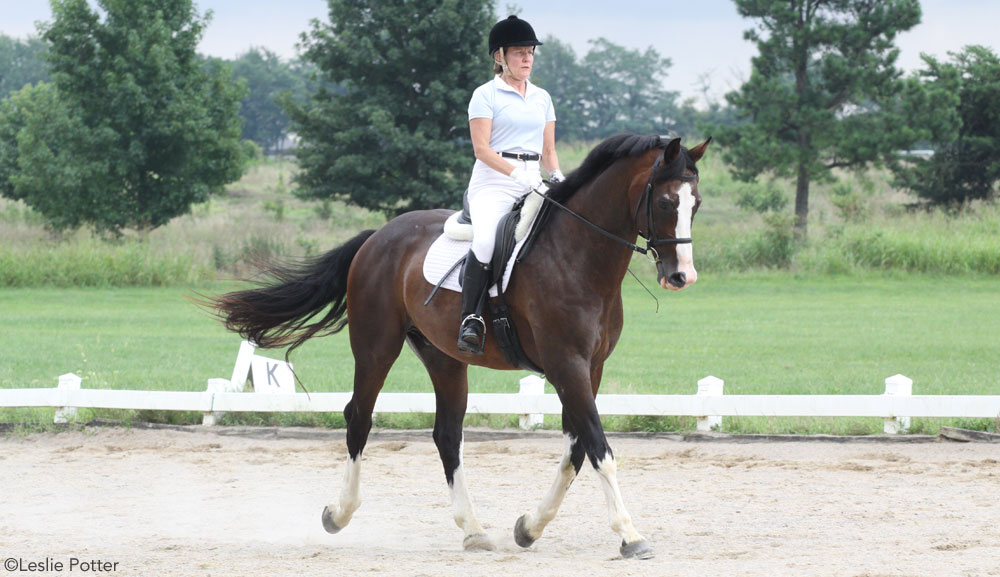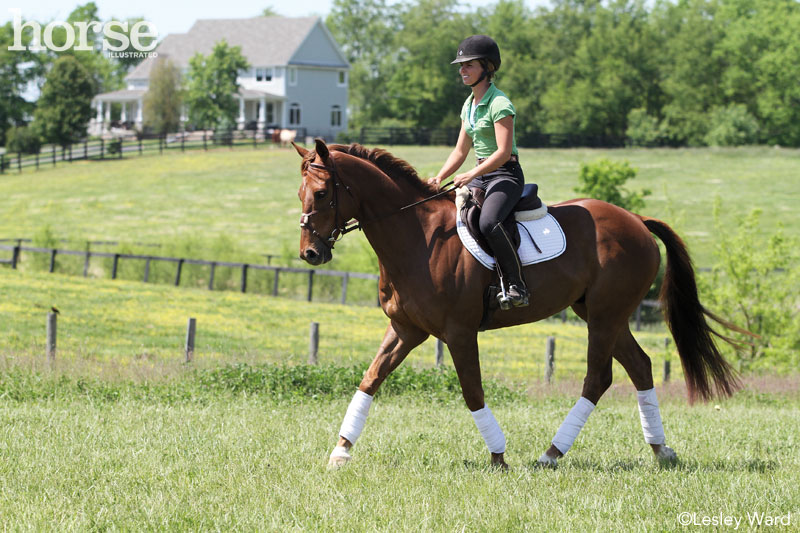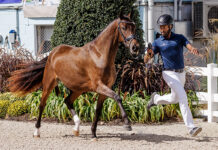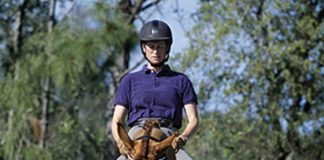
Also, if you learn to sit the trot properly, you will be a safer rider, Kass says. “You’ve got to sit correctly because you’re much less likely to fall off if the horse spooks. You are also less likely to influence the horse in ways you don’t intend to and cause him to lose his balance.” Kass is an FEI-level dressage instructor and trainer in Lewisville, Texas, and holds a United States Dressage Federation (USDF) silver medal, which is given to riders who’ve successfully ridden into the upper levels.
Todd Karn, a United States Equestrian Federation (USEF) “R” hunter and equitation judge and instructor at the Stoneleigh-Burnham School in Greenfield, Mass., says that sitting the trot is very important to the hunter rider in more ways than one. “One reason we sit in hunters is to show that the rider can sit the trot in balance and with a supple body. And in equitation you really have to do it well, and without stirrups. The other reason is to show that the horse understands the use of weight on his back and accepts it, which demonstrates to the judges that the horse is a better ride. If a horse is very touchy to sit on, he’s not a good hunter under saddle because you should be able to stay in the saddle all day while out hunting. This is what show hunters are really representing. When I compete I like to show this off.”
The Correct Position
Surprisingly, the sitting trot in both dressage and hunters demands the same position. Todd says this is because posting trot is a whole different ballgame in hunters, but the sitting trot is more similar to a basic dressage position. If you sit the trot in the slightly inclined seat used in hunt-seat posting trot, it will propel you forward over the horse’s neck, Todd says. “A rider should sit pretty vertical; not behind or in front of the motion of the horse. The rider should sit tall, not hollow or rounded, on his or her seat bones.”
In simple terms, Kass says to picture sitting similar to the way you stand on the ground. “You don’t stand with your upper body forward or back. You stand with your knees slightly bent and your hips over your feet so your foot, hip and shoulder all line up,” she says. “In the saddle you want your foot in the stirrup to be underneath your hip, with your knee bent to whatever degree your riding discipline dictates. Your shoulders should be lined up with your hip and your foot. I like the middle of the foot to be underneath the hip instead of the heel.”
For hunter riders Todd prefers the foot to be slightly more forward of the hipbone with the leg just behind the girth. He says to try not to be too worried about how low your heel should be. “Trying to lower your heel as deeply as you possibly can tends to brace the heels and make the legs too rigid. The heel should be a little lower than your toe.”
Todd adds that hunt-seat riders should lengthen their stirrup leathers one or two holes when they are working on the flat. This longer stirrup length will help get the legs around the horse. This also brings the hips and seat bones down into the saddle. “Let the weight fall down, and let your legs be like noodles resting against the horse’s body with toes up. Avoid pinching the knee and letting the lower leg come away from the horse,” he says.
Kass says to make sure your upper body is as quiet as possible. “Since your upper body is high above the horse, it has a much greater influence on his balance than other parts of your body do. If your shoulders are flopping around from side to side you can cause him to stagger sideways, in which case he may throw his head up into the air for balance.”
Getting the Feel
The trot has two phases: a phase of suspension when all four feet are off the ground, and a landing phase when two diagonal pairs of legs strike the ground. The horse “bounces” from one phase to the other as he trots along. When a horse is in his phase of suspension, the sitting trot will feel as though you are pushed up, and as he comes down on the diagonal pair of legs you will settle back into the saddle. If you are sitting the trot correctly you will absorb that up/down part of the movement in your knees, lower back and slightly in your ankles. This is why you can’t brace your leg out in front of you—no shock will be absorbed, your legs will move uncontrollably as the horse’s motion reverberates down your legs, and you will have a difficult time holding your legs still to aid your horse.
Going with the Motion
You may have noticed while longeing, the horse’s movement affects the saddle in different ways. The walk causes the saddle to move from side to side; the canter makes the saddle swing in a rotating motion; and the trot makes the saddle rise up and down. To ride in harmony you must follow these motions, just as dancers follow one another’s steps. The balanced position Todd and Kass recommend will help you stay with the saddle in a vertical position as the horse’s body goes up and down in the trot. “You definitely don’t want to resist this motion and sit like a stiff board, or you will bounce,” Todd says. “Your back and hips should be supple with a little movement to absorb the motion but not in an exaggerated way. I see a lot of stiffness with hunter riders, and it is so important to be soft through your arms, back and legs.” Use your back and stomach muscles to stick your seat to the saddle; there are many exercises, such as those detailed below, that you can do to achieve this.
Basic Skills
Both Todd and Kass agree that improving the sitting trot is best done on the longe line on a safe and willing horse in an enclosed space. But they say that you can practice off the longe, particularly if your horse is calm and willing to follow the arena wall. Therefore, feel free to implement the following exercises on the longe line or off. Since initially you’ll be holding the pommel for balance (but not for dear life, think of the pommel as a ballet barre that a dancer rests her hand on until she hones her position), you can make this easier by installing a “cheater” strap: Lace a leather strap or old flash noseband through the D-rings of your pommel. When you’re working, tie the reins in a knot and hold the buckle against the pommel or cheater strap.
While both trainers agree that riding without stirrups helps a rider learn to sit deep and follow the movement, Kass believes this is an advanced technique, while Todd feels that dropping the irons should be done right away. In the end this is your decision. However, make sure you feel safe while riding without stirrups and that your horse will allow you to make mistakes if you lose your balance.
Going With the Flow
To improve your skills and move with the motion of the horse, pick up the sitting trot and hold the pommel or strap with your outside hand and the cantle with your inside hand (this turns your body in the direction the horse is moving). Holding on in this way will help you understand how and where to sit as well as help you hold your balance.
As you sit the trot, let your upper body press your seat into the saddle. To do this you have to have a relatively still stomach and a flexible back without wiggle waggle (that tilting forward and back on the pelvis that people often do). Don’t belly dance, hollow your back and stick your butt out behind you or pitch your shoulders forward in order to absorb the shock of the trot. Instead, try to make the pressure on your seat bones always the same. This means your seat bones will stick to the saddle during both the rise and fall of the trot. Within a few steps you will begin to feel your stomach muscles tiring (similar to the feeling of doing stomach crunches), and you may even be a bit sore the following day. This means you are sitting correctly. In the beginning, you may only be able to sit the trot around one circuit of the arena. This will increase as your muscles get stronger and your stamina improves.
Hold the saddle with your hands enough to keep yourself from falling off, but try not to hold on with a death grip or else your shoulders will get stiff and you will bounce. As you get better, loosen your hold so that your back can learn to stay with the saddle.
“It is very important in this exercise that you don’t grip with your butt, thighs or calves,” Kass says. “If you grip you are going to bounce because you will be holding yourself down with the wrong muscles.”

Finding Your Seat Bones
If you’re having trouble locating your seat bones, pick up the walk, hold the saddle as described above, and tilt your body back. Lift your knees away from the saddle and high, about level with your horse’s withers. Lower your knees and hold the same pressure with your stomach muscles to keep your seat bones down in the saddle. If you find it too difficult to hold both knees up, try it first with one knee and then the other; hold both knees up as your stamina increases. After you get the hang of this at the walk, try it at the sitting trot.
Stiff Positions
Todd and Kass say people also bounce because they get stiff in their shoulders. To combat this, learn to relax your arms with this exercise: While holding the outside hand on the pommel, circle your inside arm backward as if you’re swimming the backstroke, calmly and with a soft shoulder, in the same rhythm as the horse’s movement. Switch to the other arm, and when you feel comfortable circle both arms, grabbing the pommel when necessary.
A variation on this exercise is the shoulder shrug. While lightly holding the pommel with both hands, shrug your shoulders up, back and around in a circle. Again, try this first at the walk and then move into the trot.
Some riders hold tension in their neck at the sitting trot and look as though they might crack at any minute, Todd says. “They can’t even look around the ring. On the other hand, I’ve also seen the too loose neck, that exaggerated head bob, which also isn’t correct. To soften your neck, turn it from right to left. Riders also get mesmerized and either stare down at the horse’s neck or straight ahead, which also creates a stiff neck. To train yourself out of the thousand-yard stare, try to vary your gaze by looking around the arena as you ride.
To learn to hold your body straight in the sitting trot, Kass says to ride with your arms on either side of the horse’s neck in a sort of tunnel, keeping the horse’s neck in the middle. Follow the turns of the arena or circle in the same way, your arms following your horse’s neck.
If you find yourself falling off to one side or the other while sitting the trot, Kass suggests holding up the arm on the opposite side and putting the leg down from the hip on that same side. For example if you’re falling to the right, lift your left arm and put your left leg down. “This will correct a collapsed hip.”
Advanced Exercises
To strengthen your back, pick up the sitting trot, hold one arm up as if you’re raising your hand to ask a question, then pull it slightly back so that you can feel your muscles engage. The other hand can hold onto the pommel for support.
If you’ve decided to wait to drop your stirrups, and you’re balanced and secure with your seat, now may be the time to drop them and try all of the above exercises. You can also vary this by asking the horse to move out in a stronger, more forward trot with stirrups and then without.
By this time you should also be able to pick up the reins; however, check to make sure you are ready. Put your hands in the rein holding position with no reins, and see if your hands jump up and down at the trot. If they do, you need to relax your elbows and shoulders. You can also rest the bottom part of your hand on the pommel as you work to stabilize your hands at the sitting trot. Your elbows should open and close, otherwise your hands will jump.
Final Advice
“Everybody has their own interpretation of sitting,” Todd says. “I used to take lessons with Olympic show jumper Joe Fargis, and he told me to just sit beautifully. And when I asked him what that meant, he said that sitting is everyone’s interpretation. That advice has helped me greatly over the years.”
As our experts have explained, a balanced seat with a supple body will hold you in good stead in the sitting trot, no mater which style of riding you choose.
Further Reading
Sitting Trot in Style
Perfecting the Posting Trot
Sharon Biggs is the author of In One Arena.
This article originally appeared in the August 2005 issue of Horse Illustrated. Click here to subscribe.






